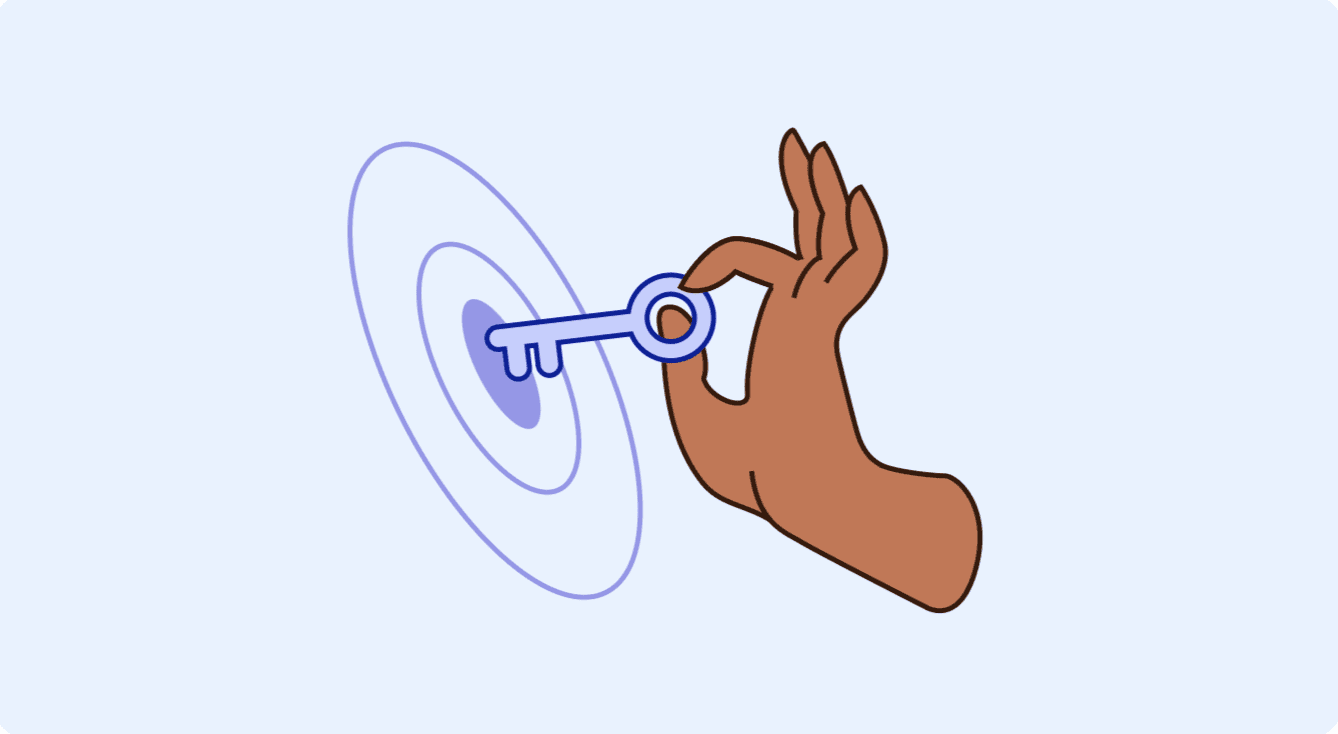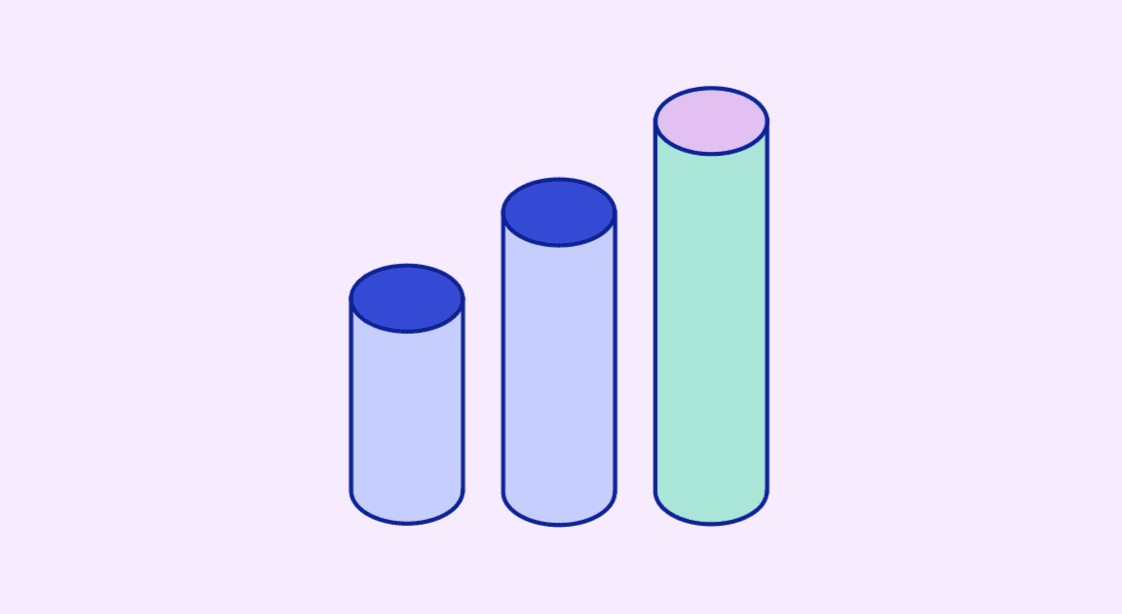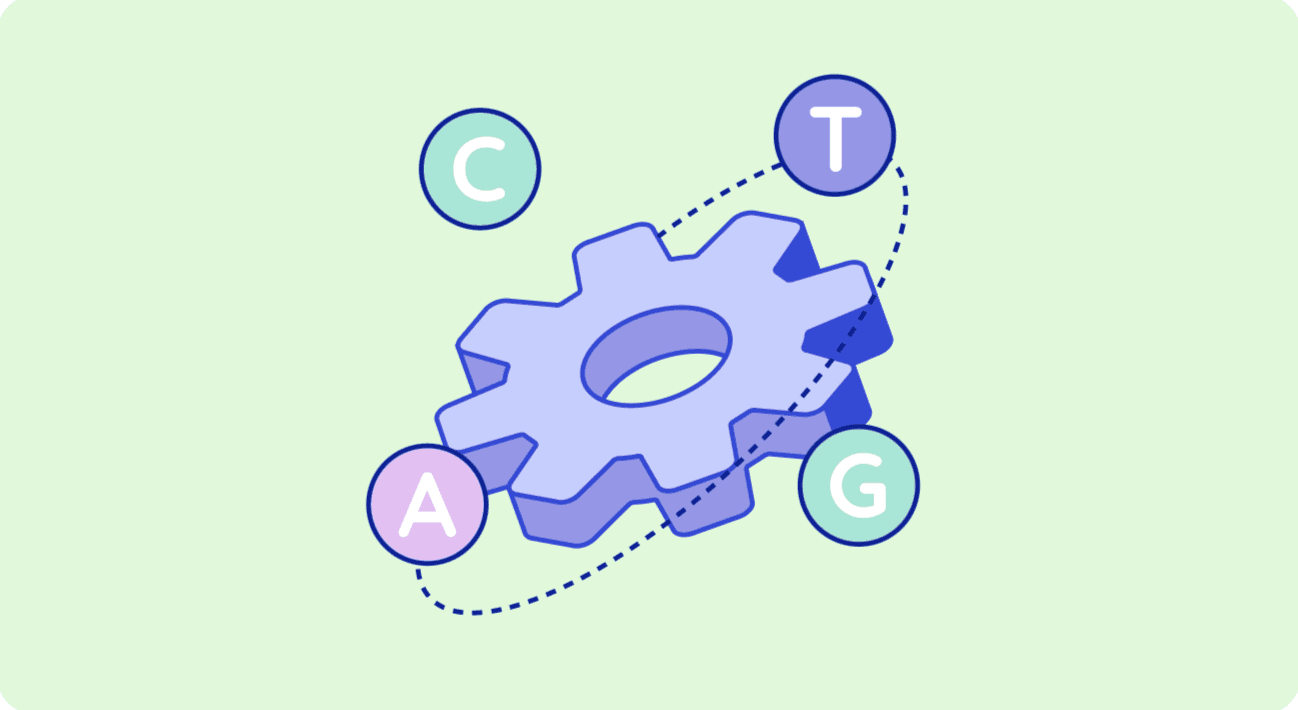01
The human genome
DNA is the language of life.
Your DNA is made of a long, unique sequence of about 6 billion chemical bases represented by the letters A, C, G, and T. The entirety of one's DNA, every one of these billions of letters, is referred to as the "genome".
All organisms, including humans, fruit flies, cows, and fish, begin from DNA.
If all animals start off as DNA, though, how are we all unique? It’s because not every species has the exact same sequence of DNA letters in their genomes. For example, human beings and dogs share 94% of their DNA. It’s that 6% that makes all the difference (1).
How about among humans? Although your genome is essentially the same as every other person, there's an average of about 30 million DNA letters that differ between people. This means the genomes of two individuals typically differ by around 0.5% (2).
These 30 million letters, called variants, help explain your uniqueness, including your disease and trait dispositions — from specific cancer risks to the severity of allergies.
Nucleus' core mission is to see how the variants in your genome help shape who you are so you can live a healthier and more informed life. Let's dive in.
02
What are variants, and how do they work?
The first thing to note is that variants aren’t all created equal — they each have a different magnitude of effect. We can divide variants into three general categories: causal, high-effect, and common.
Variant type #1: Causal variants
If you have a causal variant, you have the disease or trait.
Some variants are causal. These variants are entirely responsible for whether a person develops a disease or trait. Often termed "pathogenic variant," this usually refers to a DNA difference that can single-handedly cause a feature.
Let’s look at our friends, Karl and Maya, to illustrate how variants work.
One day, while strolling in the park, a radioactive spider suddenly jumped off a tree and bit Karl and Maya. Neither of them turned into a superhero (unfortunately, it wasn't that kind of spider), but they did develop some DNA variants.
The variant in Karl's DNA unfortunately caused him to develop a disorder called congenital sucrase-isomaltase deficiency (CSID). Karl can't eat fruit again without risking severe stomach pain and other issues.
If he wasn't a cartoon character, Karl would likely have inherited this causal variant for CSID from his parents. Other monogenic diseases like CSID include cystic fibrosis, Tay-Sachs disease, and sickle-cell anemia.
Here's the thing: Causal variants, while powerful in impact, are pretty rare. They don’t cause many of the diseases you’ve probably heard of.
Most DNA variants, unlike causal variants, influence but don't guarantee the development of diseases and traits. These can be divided into high-effect variants and common variants.
Variant type #2: High-effect variants
Unlike Karl, our friend Maya didn't develop one causal variant. She developed several different variants — none of which were causal.
The first type was high-effect variants. These variants have a significantly high effect on your disease risks and trait dispositions. But they don't single-handedly cause either by themselves, as causal variants do.
One well-known example of high-effect variants are those in the BRCA1 gene. A BRCA1 variant doesn't cause breast cancer but significantly increases a person's risk of developing the disease. So high-effect variants significantly contribute to, but do not cause, diseases and traits.
Variant type #3: Common variants
The second kind of variant Maya has is common variants.
These variants have small effects on your diseases and traits, and tend to be more common compared to high-effect variants.
One of these variants won't significantly affect your disposition toward a disease or trait. But several of them working in combination can have a meaningful impact.You have to consider common variants jointly, seeing how they, alongside any high-effect variants, collectively dispose you towards a feature.
So, Karl developed a single variant causing him to get CSID. Maya's variants, however, work collectively to affect multiple aspects of her health and personality, whether predisposing her to diseases like type 2 diabetes, or influencing characteristics like her muscle strength or her inclination to take risks.
In reality, people don’t just have a causal variant, high-effect, or common variants. They can have a mix of the three.
From monogenic to polygenic features
Here’s the moral of the fable of Karl, Maya, and the spider: Most DNA variants work together to shape your characteristics. It’s usually not a single variant that causes a feature.
Familiar diseases and traits like cancers, heart disease, height, or extraversion are products of many of these common variants, or a mix of high-effect and common variants collectively influencing your risks and traits. These sorts of features are called "polygenic."
But when it comes to polygenic features, genetics isn’t destiny — your lifestyle, family history, clinical factors, and environment are also important variables to consider.
You might now be curious to discover what variants are in your DNA.
Well, now you can find out!
03
Testing your DNA: Traditional genotyping vs. whole-genome sequencing
To start, you'd have to get a DNA test to see which variants you have.
Currently, most consumer genetic testing companies use a testing technology called genotyping. Genotyping, though, only captures a small subset of your variants, severely limiting the genetic analysis that one can provide. Instead of analyzing all possible DNA letters in one’s genome, genotyping only looks at about 700,000. And nearly all of the 700,000 variants that genotyping does capture are actually common variants.
This means an average of 30 million letters that affect your disease risks and trait dispositions go unaccounted for in this kind of genetic test. This includes missing nearly all high-effect and causal variants! It’s basically looking at just a small portion of your genome.
Genotyping does have some value. That's why Nucleus customers can upload their genetic data from another consumer genetic testing company onto our platform. However, to get the most out of genotyped data, you have to consider the combined impact of common variants.
That's why, over several years, our scientists developed innovative algorithms called polygenic scores that combine up to a million of these common variants into a number that assesses your disposition for a plethora of diseases and traits. We also call them common genetic scores, because they tell you your disease risks or trait dispositions based on the effect of common variants in your genome.
We want to make sure that the partial snapshot of DNA information that you may already have provides you with as much useful information about your health and traits as possible. We are proud that our innovative common genetic scores do just that.
So, if you want to experience more and better genetic analysis, we welcome you to upload your DNA and begin your Nucleus experience.
That said, there’s more to genetic analysis than just looking at this small snapshot of DNA. Whole-genome sequencing, unlike genotyping, is a genetic testing technology that captures nearly all your DNA information, including all high-effect and causal variants. This makes whole-genome sequencing more comprehensive than basically any other consumer and clinical genetic test on the market.
People who get their whole genomes sequenced at Nucleus will receive an extensive assessment of their health and trait dispositions, along with appropriate personalized next steps.
To illustrate the difference between genotyping and whole-genome sequencing, let's go back to our friend Karl for a second.
Karl is probably worried about the possible effects of a radioactive spider bite on his DNA. But if he opts for a simple genotyping test from a typical consumer genetic testing website, that test would show that Karl is fine.
In the meantime, Maya is also worried about that spider bite because she's heard that exposure to radioactivity can increase your cancer risk. So she's also opted for a genotyping test from a well-known consumer genetic testing company to determine if her breast cancer risk has increased.
What Maya doesn't know is that there are more than 23,000 possible high-effect variants that can significantly increase your risk of developing breast cancer. And some genotyping tests check for three of them at most. Three out of 23,000! This means that with a genotyping test, Maya can have a high risk of developing breast cancer and, unfortunately, have no idea.
This is serious business. Fortunately, after getting Nucleus’ comprehensive whole-genome sequencing, Karl and Maya can see the full effects of their variants, and not just a tiny snapshot.
A quick explanation of variants
Genes produce proteins, which are made up of molecules called amino acids. These proteins perform various actions throughout your body. High-effect and common variants can be broken down into several categories, and they all work in different ways to affect the production or function of these proteins (4,5,6).

References
1
Ostrander EA, Wayne RK. 🔗 The canine genome. Genome Res. 2005 Dec;15(12):1706-16. doi: 10.1101/gr.3736605. PMID: 16339369.
2
Levy S, Sutton G, Ng PC, et al. 🔗 “The diploid genome sequence of an individual human.” PLoS Biol. 2007 Sep 4;5(10):e254. doi: 10.1371/journal.pbio.0050254. PMID: 17803354.
3
Ségurel L, Bon C. 🔗 On the evolution of lactase persistence in humans. Annu Rev Genomics Hum Genet. 2017 Aug 31;18:297-319. doi: 10.1146/annurev-genom-091416-035340. Epub 2017 Apr 19. PMID: 28426286.
4
Clancy, S. (2008) 🔗 Genetic mutation. Nature Education 1(1):187
5
🔗 “What kind of gene variants are possible?” MedlinePlus.
6
🔗 "The sound of a silent mutation” Science.
Keep exploring



















